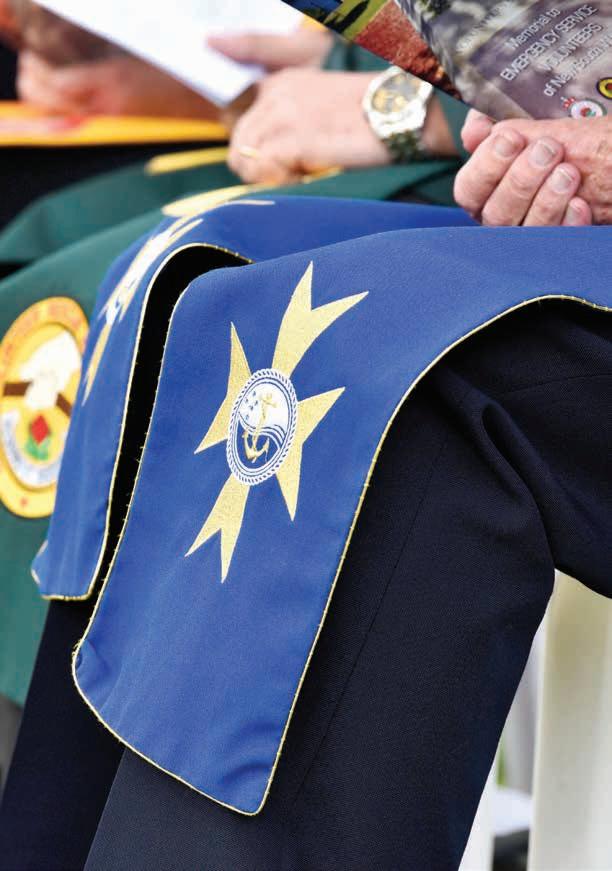
6 minute read
People & resources: Might & power
PEOPLE & RESOURCES
Tuggerah Lakes 20, on its sea trials off Yamba, has “already given us additional confidence in our ability to serve the community safely”, says Deputy Unit Commander Bob Sutton. Photo: Yamba Welding & Engineering.
MIGHT & POWER
The 100th vessel ... Lord Howe 40 undergoes a total refurbishment after MRNSW took delivery of the boat from the NSW Police Force.
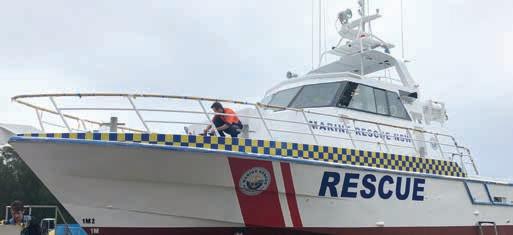
Another vessel was added to the Marine Rescue NSW fleet every five weeks on average this year, boosting volunteer safety and operational capability.
Marine Rescue NSW has passed a significant milestone in the development of its world-class rescue fleet, with more than 100 new and refurbished vessels now delivered under the Fleet Modernisation Program, at a total cost of more than $24 million.
Ten vessels were added to the fleet in 2019-20, taking the total number of boats delivered to units to 101. These 10 were the first of 38 vessels to be funded under an accelerated fleet renewal package worth almost $15 million over four years as part of a State Government investment of $37.6 million in MRNSW from July 1, 2019.
The landmark 100th boat delivered was the largest in the fleet, the 16m ocean-going launch Lord Howe 40 (Fearless). The former NSW Police Force Marine Area Command boat, which MRNSW acquired at no cost, has undergone a full refurbishment at Birdon Marine in Port Macquarie, ahead of its deployment to the first offshore MRNSW rescue unit on Lord Howe Island when COVID-19 restrictions ease. The work included gutting the interior, building a new wheelhouse console, renewing the flybridge console, installing a full suite of Raymarine electronics, a mechanical overhaul and replacing bearings and corroded plates. The shafts and propellers were removed, inspected and aligned and the hull was blasted and the superstructure repainted before the vessel was re-launched in MRNSW livery.
Boats from the existing fleet also were upgraded this year, including Batemans 30, which underwent a major half-life refit expected to extend its operational lifespan by seven to 10 years, with new electronics, communications, cabin layout, engine mounts and fuel lines, re-machined or replaced shafts and bearings and new livery. Wooli 30 benefited from a new interior fit-out, upgraded electronics, new pontoons and fresh paint and livery.
Almost $310,000 in fuel was used to power our operational fleet of more than 90 vessels across the 12 months.
The strategic allocation of rescue resources under the Fleet Modernisation Program has continued to ensure crews operate on fit-for-purpose vessels designed and built to suit local conditions and handle the heavy operational workload of search and rescue, whether offshore, on coastal bars or more
NEW VESSELS 2019-20
Lord Howe 40 (Fearless), 16m Austal
Newcastle 30, 10m Naiad
Lemon Tree 30, 8.5m Naiad
Tuggerah Lakes 20, 6.8m Naiad
Sussex Inlet 20, 7.5m Ocean Cylinder
Merimbula 20, 6.8m Naiad
Port Kembla 20, 6.3m Naiad
Nambucca 12, Sea-Doo RWC
Narooma 11, Sea-Doo RWC
Narooma 12, Sea-Doo RWC
Total 700,000
535,000
450,000
355,000
343,000
337,000
306,000
18,000
18,000
18,000
3,080,000
The trial of the U SAFE prototype is launched from rescue vessel Botany 30 in a rescue simulation.
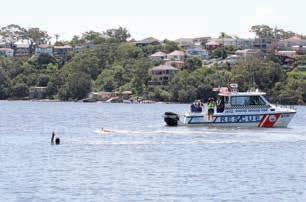
We launch Australia-first technology trial
As part of its commitment to innovation, MRNSW this year launched the first Australian trial of new rescue technology, the U SAFE selfpropelled, remote-controlled life buoy.
The prototype, produced by Portugese developer Noras Performance, was trialled to determine its capability in a marine rescue environment.
Featuring a U-shaped hull, the device can travel up to 400 metres from the operator on a vessel or shore at a speed of up to 15km/h.
Unlike a traditional life ring thrown to a person in the water and then hauled back to land or a rescue vessel, the U SAFE is selfpowered by an electric turbine in each leg.
Fleet Manager Kelvin Parkin said MRNSW had undertaken the first operational trial of the U SAFE by a professional rescue service in Australia.
The trial tested its potential capacity to either retrieve a person from the water or carry a tow line to a boat in dangerous or inaccessible locations, such as on coastal bars or near rocks.
Mr Parkin said while MRNSW had decided not to introduce the equipment as part of its vessel fit-out, it was important to test new products that had the potential to assist volunteers in their life-saving roles.
“Innovation is a strong driver in our mission to save lives on the water,” he said. “If we can find new ways to help our volunteers work smarter and safer rather than harder, then we will investigate those possibilities. It is only through testing and trials that we continue to develop.”
The equipment weighed 13kg. It was powered by a 3.6 volt lithium ion battery, with a run time of 30 minutes at a speed of 7.5km/h. confined inshore waterways. The organisation’s momentum on the water is being maintained, with new vessels due for delivery to MR Broken Bay, Botany Port Hacking, Tuross and Jervis Bay in the second quarter of 2020-21.
MRNSW not only aims to keep pace with new industry developments but also to continue to be a leader in the marine search and rescue sector. The size and scope of the build program is so extensive that the organisation needs the flexibility of a number of builders working simultaneously to meet our delivery and budgetary targets.
To help support its remarkable rate of growth and the organisation’s focus on innovation in the design of larger offshore vessels, a partnership was this year established with a new boat builder, Harwood Marine. The first boat commissioned from Harwood is a 12 metre aluminium monoholl to replace the 13.5m Steber, Jervis Bay 40, which is approaching its rescue retirement.
MRNSW is a committed supporter of the NSW boat building industry, not only for ease of access during construction, maintenance and servicing but also to provide valuable skilled employment in regional centres. Yamba Welding & Engineering - which builds our Naiad and Ocean Cylinder vessels - acquired international design company Naiad New Zealand this year.
ROAD FLEET Regional Operations Managers’ vehicles were renewed this year, with new Toyota Landcruisers delivered under a preferred supplier agreement with Stewart Toyota in the Sutherland Shire. The vehicles are the first to be customised with eye-catching modern graphics reflecting new MRNSW brand designs incorporating a wave motif. The designs will be added to other vehicles as they are replaced.
CREW SAFETY A market review of Personal Protective Equipment for Rescue Water Craft operators was conducted during 2019-20, resulting in the introduction of new lifejackets. The Forward WIP Impact jackets are a more comfortable and less restrictive fit for all operators. Fitting close to the body to prevent the operator being snagged by overhanging vegetation or floating debris, the jacket’s neoprene grip strips, on the inside, grip the operator’s wetsuit to prevent the vest from riding up. They feature zipped accessory pockets for items such as personal locator beacons, a specific shoulder pocket for a radio, easily adjustable straps and removable bibs printed with the MRNSW roundel.
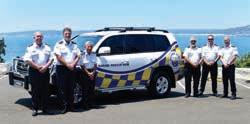
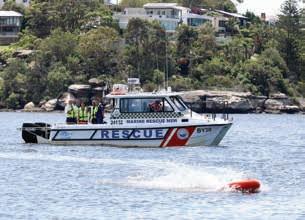
MRNSW on the road ... Regional Operations Managers Randall Gawne, Steve Raymond, Bruce Mitchell, Glenn Evans and John Murray and Fleet Manager Kelvin Parkin with the first vehicle to feature the wave motif.
HONOURING THEIR SACRIFICE
We remember those who have paid the ultimate price while serving our community, including three marine rescue volunteers, at the Emergency Services Memorial Service.
